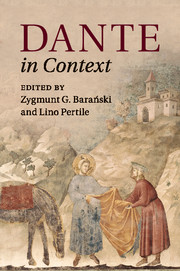Book contents
- Frontmatter
- Dedication
- Contents
- List of illustrations
- List of maps
- Notes on contributors
- Chronology
- Abbreviations and note on translations
- Introduction
- Part I Politics and society
- Part II Intellectual traditions
- Part III Linguistic and literary cultures
- Part IV Visual and performative culture
- 24 Illumination, painting, and sculpture
- 25 Architecture and urban space
- 26 Music
- Part V Dante: life, works, and reception
- Further reading
- Index
24 - Illumination, painting, and sculpture
from Part IV - Visual and performative culture
Published online by Cambridge University Press: 05 October 2015
- Frontmatter
- Dedication
- Contents
- List of illustrations
- List of maps
- Notes on contributors
- Chronology
- Abbreviations and note on translations
- Introduction
- Part I Politics and society
- Part II Intellectual traditions
- Part III Linguistic and literary cultures
- Part IV Visual and performative culture
- 24 Illumination, painting, and sculpture
- 25 Architecture and urban space
- 26 Music
- Part V Dante: life, works, and reception
- Further reading
- Index
Summary
Dante is often described as a very visually informed observer. This sensitivity is owed in part to his exposure to the rich visual culture that surrounded him from an early age, in Florence and Tuscany where he spent the first thirty-seven years of his life, in northern Italy (Verona) and Ravenna where he ended his life, and in centres such as Rome, Milan, and Venice on diplomatic missions. Little is known of the relationships he may have had with artists who, like him, were protégés of foreign courts. His writings record very few artists by name. Some of those he does name are well known to us, such as Cimabue (d. 1302) and Giotto (1266/67–1337); others have left few traces, including illuminators, on whom more below. Dante's interest in these men is moralizing: he uses them as agents of sin and of the vanity of artistic pride in particular, and perhaps to explore the connections between poetry and the visual arts. His encounter with painters and illuminators nonetheless serves as an important testimony to reception before the emergence of the history of art. Above all, the world Dante observed included the carved, painted, and built environment, and provided rich and complex metaphors whose effect on his work continues to be debated.
As a boy, Dante would have grown up surrounded by paintings, mosaics, carvings, and reliefs from wood and stone to metalwork and ivory, and would have become intimately acquainted with certain buildings and their decorative programmes, particularly in his native Florence. His Christian journey began at the large stone font of the Baptistery of San Giovanni where he was baptized in 1266 and where he dreamt of being crowned poet laureate (Par. XXV, 7–9). The font was demolished in 1576 and thus survives only in fragments, but was probably square or octagonal, decorated with slabs with a delicately carved border and centre, inlaid with green marble and, as was customary, round compartments (battezzatori) for the priests to stand in (see Inf. XIX, 16–20). Pisa's baptistery font, from the mid thirteenth century, has similar decoration, four battezzatoriand its central space is lined with multicoloured marble. In the Florentine baptistery, a large section of the tessellated floor is well preserved and displays complex motifs (birds, animals, foliage) in inlaid marble created in two phases and using two techniques.
- Type
- Chapter
- Information
- Dante in Context , pp. 401 - 426Publisher: Cambridge University PressPrint publication year: 2015
- 1
- Cited by

